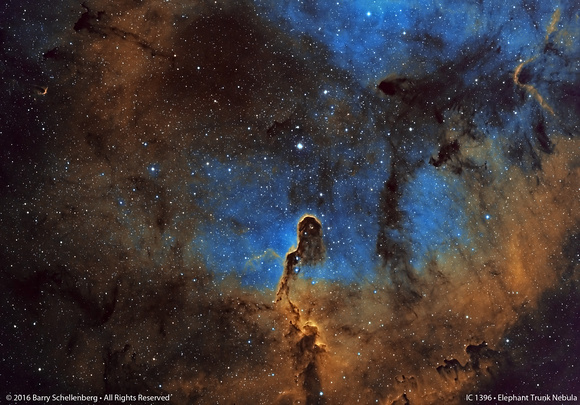Other Names: SH2-131
Optics: Borg 101ED at f/4.1
Mount: Paramount MX using
The SkyX Pro Camera: QSI 683WS-8 Filters: Astrodon Ha 3nm, OIII 3nm, SII 3nm
Exposure: 3580 Mins or 59 2/3 hours, [33 1/3 Ha, 14 2/3 OIII, 11 2/3 SII], Binned 1x1, 1200s exposures
Accessories: Feathertouch focuser using
FocusMax 4.1.0.40 Location: Burlington, ON Date: Taken over several nights and several months from August 27th, to November 4th, 2016
Notes: This is the longest acquisition time I have put into one image to date. This is also my first
Unguided Image using Software Bisque's TPoint & Protrack software. No guiding of any kind was used for any of the 60 hours of acquisition. Image acquisition was done with
TheSkyX Pro CAO using
MaxPilote automation software.
Processing: Image calibration, align, and combine in Maxim DL Pro. Levels, curves, SHO colour mapping, cosmetic adjustments and crop/resize completed in Photoshop CS5.
Calibrated w/20 Darks, 100 Bias, 50 Flats of each filter using a flat pannel.
CCD temperature was -25C. Image was taken from my backyard
Observatory.
Selected as Sky News Photo of the Week: http://www.skynews.ca/photo-of-the-week-the-elephant-trunk-nebula-by-barry-schellenberg/ Profiled in Software Bisque's advertisement in Sky & Telescope: https://www.dropbox.com/s/xrbr889lsohl9vm/Inspirational%20Ad%20Full%20Bleed.pdf?dl=0 Link to Ha: http://astromarina.zenfolio.com/p264248004/h3d606a89#h3d606a89 The
Elephant's Trunk nebula is a concentration of
interstellar gas and dust within the much larger ionized gas region IC 1396 located in the constellation
Cepheus about 2,400
light years away from Earth.
[1] The piece of the
nebula shown here is the dark, dense globule IC 1396A; it is commonly called the Elephant's Trunk nebula because of its appearance at visible light wavelengths, where there is a dark patch with a bright, sinuous rim. The bright rim is the surface of the dense cloud that is being illuminated and ionized by a very bright, massive star (
HD 206267) that is just to the west of IC 1396A. The entire IC 1396 region is ionized by the massive star, except for dense globules.


